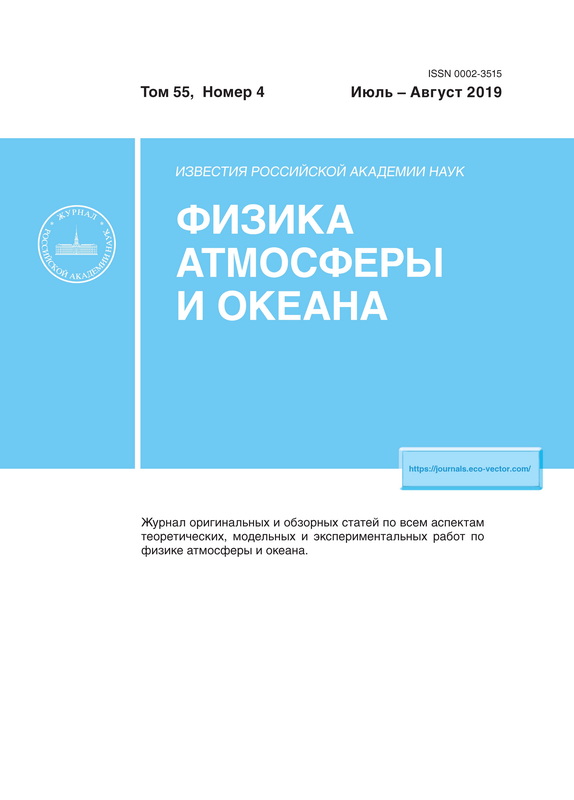Меридиональный перенос донной воды в Южной Атлантике
- Авторы: Беляев К.П.1,2, Морозов Е.Г.1, Тучкова Н.П.2
-
Учреждения:
- Институт океанологии им. П.П. Ширшова РАН
- Вычислительный центр им. А.А. Дородницына ФИЦ ИУ РАН
- Выпуск: Том 55, № 4 (2019)
- Страницы: 73-81
- Раздел: Статьи
- URL: https://journals.eco-vector.com/0002-3515/article/view/16124
- DOI: https://doi.org/10.31857/S0002-351555473-81
- ID: 16124
Цитировать
Полный текст
Аннотация
Приводятся оценки меридионального потока массы в слое Антарктической донной воды, рассчитанные по совместной модели «океан–земля–атмосфера» Earth System Model c применением оригинальных методов усвоения данных наблюдений. Для усвоения использовались данные широтных CTD-разрезов температуры и солености международного эксперимента WOCE. Даны оценки скоростей течений Антарктической донной воды с усвоением данных наблюдений. В качестве метода усвоения использовался авторский метод усвоения, названный ранее обобщенным методом Калмана (Generalized Kalman Filter, GKF), который совпадает в частном случае с классическим методом Калмана (EnKF). Проведены также расчеты переноса по динамическому методу. Показано, что модельные расчеты с усвоением данных качественно совпадают и количественно близки к оценкам переноса геострофического потока на основе динамического метода.
Об авторах
К. П. Беляев
Институт океанологии им. П.П. Ширшова РАН; Вычислительный центр им. А.А. Дородницына ФИЦ ИУ РАН
Автор, ответственный за переписку.
Email: egmorozov@mail.ru
Россия, Москва
Е. Г. Морозов
Институт океанологии им. П.П. Ширшова РАН
Email: egmorozov@mail.ru
Россия, Москва
Н. П. Тучкова
Вычислительный центр им. А.А. Дородницына ФИЦ ИУ РАН
Email: egmorozov@mail.ru
Россия, Москва
Список литературы
- Arhan M., Mercier H., Bourlès B., Gouriou Y. Hydrographic section across the Atlantic at 7°30’ N and 4°30’ S // Deep-Sea Res. 1998. V. 45. P. 829–872.
- Jungclaus J.H., Fischer N., Haak H., Lohmann K., Marotzke J., Matei D., Mikolajewicz U., Notz D., Storch J.S. Characteristics of the ocean simulations in the Max Planck Institute Ocean Model (MPIOM) the ocean component of the MPI-Earth system model // J. Advances in Modeling Earth Systems. 2013. V. 5. № 2. P. 422–446. doi: 10.1002/jame.20023
- Lemarie F., Blayo E., Debreu L. Analysis of oceanatmosphere coupling algorithms: consistency and stability // Proc. Computer Science, Elsevier. 2015. International Conference on Computational Science. ICCS2015 — Computational Science at the Gates of Nature. V. 51. P. 2066–2075.
- Володин Е.М., Мортиков Е.В., Кострыкин С.В., Галин В.Я., Лыкосов В.Н., Грицун А.С., Дианский Н.А., Гусев А.В., Яковлев Н.Г. Воспроизведение современного климата в новой версии модели климатической системы ИВМ РАН // Известия РАН. Физика атмосферы и океана. 2017. Т. 53. № 2. С. 164–178.
- Володин Е.М., Гусев А.В., Дианский Н.А., Ибраев Р.А., Ушаков К.В. Воспроизведение циркуляции мирового океана по сценарию CORE-II с помощью численных моделей // Известия РАН. Физика атмосферы и океана. 2018. Т. 54. № 2. С. 97–111.
- Беляев К.П., Танажура К.А.С., Тучкова Н.П. Сравнительный анализ экспериментов с усвоением данных дрифтеров АРГО // Океанология. 2012. Т. 52. № 5. С. 643–653.
- Evensen G. Data Assimilation. The Ensemble Kalman Filter. Berlin: Springer, 2009. 307 p.
- Агошков В.И., Ипатова В.М., Залесный В.Б. Задачи вариационной ассимиляции данных наблюдений для моделей общей циркуляции океана и методы их решения // Известия РАН. Физика атмосферы и океана. 2010. Т. 46. № 6. С. 734–770.
- Кауркин М.Н., Ибраев Р.А., Беляев К.П. Усвоение данных АРГО в модель динамики океана с высоким разрешением по методу ансамблевой оптимальной интерполяцией (EnOI) // Метеорология и Гидрология. 2016. № 7. C. 46–56.
- Belyaev K., Kuleshov A., Tanajura C.A.S., Tuchkova N. An optimal data assimilation method and its application to the numerical simulation of the ocean dynamics // Mathematical and Computer Modelling of Dynamical Systems. 2018. V. 52. P. 15–25.
- Belyaev K., Kuleshov A., Tanajura C.A.S., Tuchkova N. A correction method for dynamic model circulations using observational data and its application in oceanography // Mathematical Models and Computer Simulations. 2016. V. 8. P. 391–400.
- Воеводин Вл.В., Жуматий С.А., Соболев С.И., Антонов А.С., Брызгалов П.А., Никитенко Д.А., Стефанов К.С., Воеводин Вад.В. Практика суперкомпьютера «Ломоносов». Москва: 2012. Издательский дом «Открытые системы». № 7. С. 36–39.
- Antonov J.I., Seidov D., Boyer T.P., Locarnini R.A., Mishonov A.V., Garci H.E., Baranova O.K., Zweng M.M., Johnson D.R. World Ocean Atlas NOAA. 2010. Atlas NESDIS V. 2 (69), Ed. S. Levitus, 184 p. U.S. Gov. Print. Off., Washington, D.C.
- Kalnay E., Ota Y., Miyoshi T., Liu J. A simpler formulation of forecast sensitivity to observations application to ensemble Kalman filters // Tellus A: Dynamic Meteorology and Oceanography. 2012. V. 64. № 1. doi: 10.3402/tellusa.v64i0.18462
- The international thermodynamic equation of seawater: Manual and Guide. UNESCO. 2010.
- Wüst G. Schichtung und Zirkulation des Atlantischen Ozeans, Das Bodenwasser und die Stratosphäre. In: A. Defant (Ed.), Wissenschaftliche Ergebnisse, Deutsche Atlantische Expedition auf dem Forschungsund Vermessungsschiff “Meteor” 1925–1927. 1936. V. 6(1). Walter de Gruyter & Co, Berlin. 411p.
- Zenk W., Hogg N.G. Warming trend in Antarctic Bottom Water flowing into the Brazil Basin // Deep-Sea Res. 1996. V. 43. № 9. P. 1461–1473.
- Morozov E., Demidov A., Tarakanov R., Zenk W. Abyssal Channels in the Atlantic Ocean Water Structure and Flows. Dordrecht: Springer. 2010. 266 p.
- Морозов Е.Г., Демидов А.Н., Тараканов Р.Ю. Перенос Антарктических вод в глубоководных каналах Атлантики // Доклады РАН. 2008. Т. 422. № 6. С. 815–818.
- Sandoval F.J., Weatherly G.L. Evolution of the deep western boundary current of Antarctic Bottom Water in the Brazil Basin // J. Phys. Oceanogr. 2001. V. 31. № 6. P. 1440–1460.
- Морозов Е.Г., Тараканов Р.Ю. Вытекание Антарктической донной воды из канала Вима в Бразильскую котловину // Доклады РАН. 2014. Т. 456. № 2. С. 227–230.
- Rhein M., Stramma L., Krahmann G. The spreading of Antarctic Bottom Water in the tropical Atlantic // Deep-Sea Res. 1998. V. 45. P. 507–527.
- Танажура К.А.С., Лима Л.Н., Беляев К.П. Усвоение аномалий уровня океана в гидродинамической модели HYCOM по данным наблюдений со спутников в Атлантике // Океанология. 2015. Т. 55. № 5. C. 738–750.
- Koltermann K.P., Sokov A.V., Tereschenkov V.P., Dobroliubov S.A., Lorbacher K., Sy A. Decadal changes in the thermohaline circulation of the North Atlantic // Deep Sea Res. II. 1999. V. 46 (1–2). P. 109–138.
Дополнительные файлы









